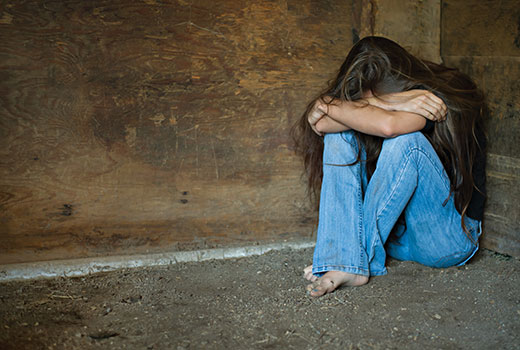Each day in South Carolina, approximately 670 people are offered up for commercial sex. One in 10 of those victims is a minor.
Greenville, situated between two of the largest cities in America for human trafficking — Atlanta and Charlotte — is the leading area of our state for child trafficking. Interstate 85 connects Atlanta, Greenville and Charlotte, and along that corridor human slavery has been on the rise.
In a book just released by B&H Publishers, “Vulnerable: Rethinking Human Trafficking,” author Raleigh Sadler points out that more than 40 million people are held in modern-day slavery. “Human trafficking is the exploitation of vulnerability for commercial gain,” he said. “Those enslaved in trafficking are hidden in plain sight. Who do traffickers look like? Easy, they look like you and me. Human trafficking happens anywhere there is vulnerability.”
Lanie George was trafficked from age 3 to 17. Her mom worked at a strip club, and when young Janie got off the bus she came to the club and did her homework. At 10 years old, she was recruited by the club to provide sexual favors for adult men. Eventually, she was able to escape that slavery and succeeded at rescuing her mother from the bondage in 2002.
George lives near Charlotte now, where she directs Redeeming Joy, a ministry designed to provide help and deliverance for those caught in trafficking. “As a second-generation survivor of sex trafficking, I am in awe each and every day to see how God has redeemed my life. Our God does redeem, restore — and loves like crazy,” she said.
Sixty percent of the budget for George’s ministry comes from churches and individuals. The services of Redeeming Love include emotional healing, substance recovery, mental renewal, family restoration, relational and social re-acclamation, community outreach, vocational and life skills development, and therapeutic self-care. A course, “Walking Alongside the Wounded,” offers two hours of training designed to equip and empower volunteer workers. The ministry has helped 275 people since 2012. George gives her testimony in churches and leads courses for individuals and churches interested in helping those who are caught in sex trafficking. She can be reached at Info.RedeemingJoy@gmail.com.
According to Sadler, human trafficking exists in all 50 states. It has become a $150 billion international industry — with $99 billion coming from commercial sexual exploitation and $51 billion generated through forced labor.
South Carolina improved from a “C” to a “B” grade last year, but because of new legislation passed in 2018 and new initiatives in place for 2019, the state could improve even more this year.
Kathryn Moorehead, chair of the South Carolina Human Trafficking Task Force, stated, “We need to prevent this crime from happening in South Carolina, and if we can’t prevent every case, we need to be prepared to provide the services that victims and survivors need.” The new legislation allows sex trafficking victims who are minors to receive services from the Department of Social Services and permits law enforcement to help get those resources to the victimized child.
According to the website of an organization called Erase Child Trafficking, children put themselves at risk when they seek attention and acceptance on the internet. “Traffickers are experts at exploiting children’s vulnerabilities and can lure a child away without ever having to use force. Statistics show that 46 children in America are taken and sold into slavery per day,” the website stated. It is an evil business driven by demand.
Traffickers can be anywhere, but some key places they target are airports, transportation hubs, after-school centers, and malls. After successfully recruiting children, they quickly send them away to other cities, or even other countries. According to Erase Child Trafficking, the exploiters move children to distant places so they will not be recognized.
According to the State Department, human trafficking includes, but is not limited, to sex trafficking, child sex trafficking, forced labor, debt bondage, domestic servitude, forced child labor, and the unlawful recruitment of child soldiers.
Kasey McClure is a member of First Baptist Church of Conyers, Ga., and founder of 4Sarah, an organization that fights human trafficking. “Slavery still exists,” said McClure. “All of those girls are in this situation because of something that has happened in their past. No little girl grows up and says, ‘I want to be a prostitute when I grow up.’”
Erase Child Trafficking and the William D. Lynch Foundation have partnered to help abolish human trafficking in South Carolina. They are currently focusing on three counties — Charleston, Berkley, and Dorchester — through the Tri-County Human Trafficking Task Force.
Child traffickers are generating $39 billion annually worldwide. Psychologist Allison Chawla has written that “America holds the title of second highest destination in the world for trafficked women. Between 14,500 and 17,500 victims are trafficked into the United States each year. In most cases the average age of the prostitute or exploited victim is between 12 and 13.” She referenced a study from the University of Pennsylvania indicating that as many as 300,000 youth were at risk for being sexually exploited for commercial uses — some as young as 4 or 5.
One of the keys in stopping human trafficking — particularly the trafficking of children — is community involvement. The church can help with this by informing, educating, and motivating members to a keener awareness of this devastating practice. We can develop trained watchdog groups to look for the signs of possible human trafficking and report our suspicions to the proper authorities. The National Human Trafficking Hotline is 1-888-373-7888.

